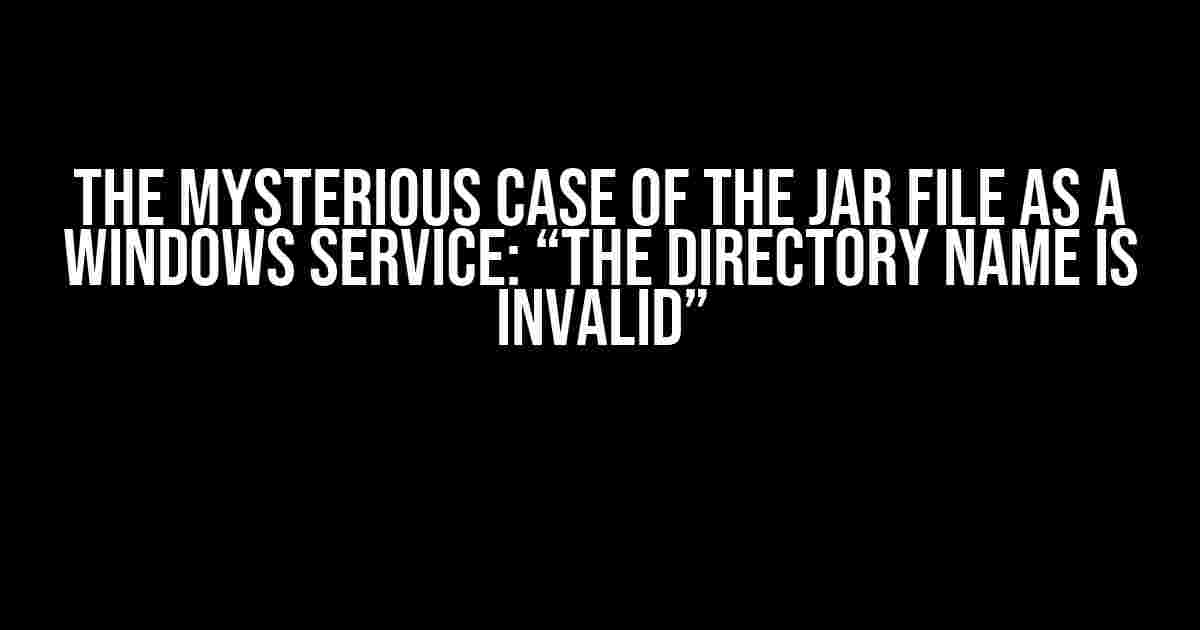Have you ever tried to run a JAR file as a Windows service, only to be met with a cryptic error message that leaves you scratching your head? You’re not alone! The “System.ComponentModel.Win32Exception: The directory name is invalid” error is a common obstacle that many developers face when attempting to deploy their Java applications as Windows services. Fear not, dear reader, for we’re about to embark on a thrilling adventure to conquer this error and emerge victorious!
The Setup: Running a JAR File as a Windows Service
Before we dive into the solution, let’s quickly review how to run a JAR file as a Windows service. There are several ways to do this, but one popular approach is to use the Apache Commons Daemon library. Here’s a high-level overview of the process:
- Download the Apache Commons Daemon library and extract it to a directory on your system.
- Create a Procrun executable (e.g., `your_service.exe`) using the `prunsrv` tool.
- Configure the `your_service.exe` file to run your JAR file by specifying the Java runtime, classpath, and main class.
- Install the service using the `your_service.exe` file.
This is a simplified outline, and there are many variations depending on your specific requirements. However, this should give you a general idea of what’s involved.
The Error: “System.ComponentModel.Win32Exception: The directory name is invalid”
Now, let’s get to the juicy part – the error message that’s got you stumped!
When you try to start the Windows service, you might encounter the following error:
System.ComponentModel.Win32Exception: The directory name is invalid at System.ServiceProcess.ServiceController.GetServiceHandle(Int32 serviceHandle) at System.ServiceProcess.ServiceController.Start() at YourService.Main(String[] args)
This error is frustratingly vague, isn’t it? It doesn’t give you much to work with. But fear not, dear reader, for we’re about to dissect this error and find the root cause.
The Culprit: Relative Paths and Windows Services
The issue lies in the way Windows services handle relative paths. When you run a JAR file as a Windows service, the service executable (e.g., `your_service.exe`) is responsible for launching the Java runtime and passing it the necessary arguments. However, the service executable doesn’t have the same concept of a “working directory” as a regular executable.
By default, the working directory for a Windows service is the system directory (e.g., `C:\Windows\System32`). This means that any relative paths specified in your configuration files or code will be relative to the system directory, not the directory where your service executable is located.
This can lead to problems when trying to access files or directories using relative paths. In your case, the error “The directory name is invalid” is likely because the service is trying to access a directory that doesn’t exist in the system directory.
The Solution: Absolute Paths to the Rescue!
Now that we’ve identified the culprit, let’s talk about the solution. The key is to use absolute paths instead of relative paths. This ensures that the service can find the necessary files and directories, regardless of the working directory.
Here are some tips to help you transition to absolute paths:
- Specify the full path to your JAR file: Make sure to specify the full path to your JAR file in the `your_service.exe` configuration.
- Use absolute paths in your configuration files: Update your configuration files (e.g., `log4j.properties`, `application.properties`) to use absolute paths for file locations.
- Avoid relative paths in your code: Refactor your code to use absolute paths when accessing files or directories. You can use the `System.getProperty(“user.dir”)` method to get the directory where your service executable is located.
For example, if your JAR file is located in `C:\Services\YourService\your_service.jar`, you should specify the full path in the `your_service.exe` configuration:
<service>
<id>your_service</id>
<name>Your Service</name>
<jvm>
<jvmarguments>
<argument>-jar</argument>
<argument>C:\Services\YourService\your_service.jar</argument>
</jvmarguments>
</jvm>
</service>
By using absolute paths, you ensure that the service can find the necessary files and directories, regardless of the working directory.
Additional Tips and Tricks
Here are some additional tips to help you troubleshoot and resolve issues when running a JAR file as a Windows service:
- Enable logging for the service: Configure the service to log errors and other information to a file. This can help you diagnose issues more easily.
- Check the service installation directory: Verify that the service installation directory is correct and that the necessary files are present.
- Test the service executable manually: Try running the service executable manually from the command line to see if you encounter any errors.
- Check for file system permissions: Ensure that the service has the necessary permissions to access files and directories.
By following these tips and using absolute paths, you should be able to resolve the “System.ComponentModel.Win32Exception: The directory name is invalid” error and successfully run your JAR file as a Windows service.
Conclusion
In conclusion, the “System.ComponentModel.Win32Exception: The directory name is invalid” error can be a frustrating obstacle when trying to run a JAR file as a Windows service. However, by understanding the root cause of the issue and using absolute paths, you can overcome this error and deploy your Java application as a Windows service.
Remember to be patient and methodical in your troubleshooting approach, and don’t be afraid to ask for help if you need it. With persistence and creativity, you can conquer even the most stubborn errors and achieve victory!
| Keyword | Description |
|---|---|
| JAR file as a Windows Service | Running a Java archive (JAR) file as a Windows service using tools like Apache Commons Daemon. |
| System.ComponentModel.Win32Exception | A .NET exception thrown when a Windows API call fails. |
| Directory name is invalid | An error message indicating that a directory name is invalid or cannot be found. |
| Absolute paths | Paths that specify a file or directory location using its full, unambiguous name, starting from the root directory. |
| Relative paths | Paths that specify a file or directory location relative to the current working directory. |
We hope this article has been informative and helpful in resolving the “System.ComponentModel.Win32Exception: The directory name is invalid” error. If you have any further questions or need additional assistance, please don’t hesitate to ask!
Frequently Asked Question
Having trouble getting your JAR file to run as a Windows Service? Don’t worry, we’ve got you covered! Check out these common issues and their solutions to get your service up and running in no time.
Why do I get a “System.ComponentModel.Win32Exception: The directory name is invalid” error when trying to start my JAR file as a Windows Service?
This error usually occurs when the Windows Service is trying to access a directory that doesn’t exist or is incorrectly configured. Check your service configuration file and make sure the directory paths are correct and the service has the necessary permissions to access them.
How do I specify the correct directory path in my service configuration file?
You can specify the directory path using the `–Startup` option in your service configuration file. For example, `–Startup dir=C:\Path\To\Your\Directory` will set the startup directory to `C:\Path\To\Your\Directory`. Make sure to replace `C:\Path\To\Your\Directory` with the actual path you want to use.
What permissions do I need to set for my Windows Service to access the directory?
You’ll need to set the `Read` and `Execute` permissions for the Windows Service account (usually `NT AUTHORITY\SYSTEM`) on the directory and all its subdirectories. You can do this using the Windows Explorer or the `icacls` command-line utility.
Can I use a relative path instead of an absolute path in my service configuration file?
While it’s technically possible to use a relative path, it’s not recommended. Relative paths can be ambiguous and may cause issues when the service tries to access the directory. Instead, use an absolute path to ensure the service can find the correct directory.
What if I’m still getting the “System.ComponentModel.Win32Exception: The directory name is invalid” error after checking my directory paths and permissions?
If you’ve double-checked your directory paths and permissions, try checking the Windows Event Log for more detailed error messages. You can also try enabling debug logging for your Windows Service to see if it provides more insight into the issue. If you’re still stuck, consider seeking help from a Windows or Java developer forum.





